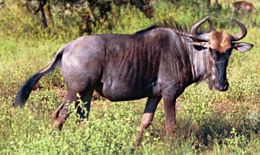Wildebeest
2008/9 Schools Wikipedia Selection. Related subjects: Mammals
| Wildebeest | ||||||||||||||
|---|---|---|---|---|---|---|---|---|---|---|---|---|---|---|
 |
||||||||||||||
| Scientific classification | ||||||||||||||
|
||||||||||||||
| Species | ||||||||||||||
The wildebeest (plural, wildebeest or wildebeests), also called the gnu (pronounced /ˈnuː/ or /ˈnjuː/), is an antelope of the genus Connochaetes. It is a hooved ( ungulate) mammal. It looks like a mixture of features between a cow and a horse.
Connochaetes includes two species, both native to Africa: the Black Wildebeest, or white-tailed gnu (C. gnou), and the Blue Wildebeest, or brindled gnu (C. taurinus). Gnus belong to the family Bovidae, which includes antelopes, cattle, goats, and other even-toed horned ungulates.
Wildebeest grow to 3 ft 9 in–4 ft 7 in (1.15–1.4 metres) at the shoulder and weigh 330–550 pounds (150–250 kilograms). They inhabit the plains and open woodlands of Africa, especially the Serengeti. Wildebeest can live more than 20 years.
Behaviour
The principal food source of wildebeests is grasses. The seasonal nature of the African grasslands forces wildebeest to migrate. The main migration is in May, when around 1.5 million animals move from the plains to the woods; they return in November as summer rains water the plains.
The name wildebeest finds its origin in the Dutch and Afrikaans words wild and beest, which mean "wild animal" and "beest" in Afrikaans means "cattle" (or "steer"). Although the name is derived from the Dutch language, the name "wildebeest" doesn't officially exist in the Dutch language; the Dutch name for wildebeest is gnoe (where the Dutch "g" is pronounced [x], as in loch).
Afrikaners (Afrikaans-speaking South Africans) may have started using the name wildebeest for the animal as they had no other name for it when it was first encountered. "Gnu" is from a Khoikhoi language (which pronounced the [g]), likely an imitation of the grunting noise that a wildebeest makes.

